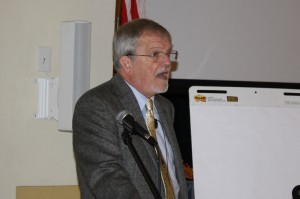 ST. ALBANS — On the same day Confederate soldiers were robbing banks in St. Albans, Oct. 19, 1864, Union soldiers from Franklin County were fighting to preserve Union control of the Shenandoah Valley in Virginia, according to Civil War historian Howard Coffin.
ST. ALBANS — On the same day Confederate soldiers were robbing banks in St. Albans, Oct. 19, 1864, Union soldiers from Franklin County were fighting to preserve Union control of the Shenandoah Valley in Virginia, according to Civil War historian Howard Coffin.
Coffin described the battle and the role played by Vermonters for an audience of more than 50 people as part of a Vermont Academy of the Arts and Sciences Conference on Vermont in the Civil War at the St. Albans Historical Museum on Saturday.
Soldiers from Vermont’s 8th Regiment – which was partially recruited in St. Albans — played a key role in the battle for Cedar Creek. Coming just weeks before the presidential election of 1864, the Union victory bolstered Lincoln’s re-election campaign.
The roots of the battle lay in an ill-fated effort in March 1864 to free 15,000 Union soldiers being held in Richmond by the Confederacy. The raid failed and it’s organizer, Col. Ulric Dahlgren, was killed. On his body, Confederates found instructions ordering the capture or assassination of Jefferson Davis.
“The Confederates were absolutely furious and they decided to retaliate,” said Coffin.
That same spring Ulysses S. Grant was given full command of Union war efforts. The Shenandoah Valley held strategic importance as a route north to Washington, D. C. and beyond. It was also a source of food for the Confederate capital of Richmond.
Following a 40-day overland campaign that resulted in 80,000 dead in the spring of 1864, the Union lay siege to Richmond and Petersburg, explained Coffin.
Lee dispatched 15,000 soldiers under the command of Lt. Gen. Jubal Early to “raise all the hell that they can,” said Coffin. The action was taken in the hope that Grant would be forced to pull some troops away from Richmond and Petersburg.
Early made an effort to attack Washington, D. C. but was blocked by a sizable Union army.
Grant placed three army corps under the command of Maj. Gen. David Hunter to halt Early’s activity in the valley, but quickly replaced him with Maj. Gen. Philip Sheridan.
Coffin described Sheridan as “a born fighter, 5 feet 4 inches tall.”
“Abraham Lincoln once said of Sheridan that he could scratch his knees without bending over,” said Coffin, describing Sheridan’s long arms.
For a few weeks the two armies maneuver around each other in the valley. In September, Grant met with Sheridan. A Vermont soldier who witnessed the meeting wrote home that he was concerned after seeing Grant because “whenever that old cuss shows up it always means fighting,” said Coffin.
Fighting did, indeed, follow. On Sept. 19, Sheridan attacked Early’s forces near Winchester, Va., and Early was forced to retreat south.
With Early on the run, Sheridan carried out the rest of his orders – a scorched earth campaign. Union soldiers burned crops, mills and barns throughout the Shenandoah Valley before the three union armies settle in at the northern end of the valley.
Sheridan left his forces to travel to D. C. to confer with Grant. Meanwhile Lee replenished Early’s forces, bringing them to 20,000. And Early saw a weakness in the Union lines. The armies were camped along rivers, but there was space between the river’s banks and the Union’s 8th Corps.
Early sneaks his forces across the river in the night, wedging his soldiers between the river and the Union army.
The ensuing battle went poorly for the Union. At one point, three regiments, including the 8th Vermont, were ordered to hold a small hill. They held it for 20 minutes.
Coffin quoted a Vermont soldier’s description of that fight: “I never on any battlefield saw so much blood as this.”
Another wrote, “Men seemed more like demons than human beings.”
Union soldiers on that hill were surrounded, with men being shot from two directions at the same time. Sixty-two percent of the men trying to hold the hill were lost in just 20 minutes including 110 of the 164 Vermonters in the 8th Regiment.
“By 8:30 a.m. Cedar Creek is a union disaster,” said Coffin. By 9:30 Union forces were in retreat.
A portion of the Union’s 6th Corps makes a stand on a curving hilltop, among them is Vermont’s 6th Brigade, as well as a regiment from Buffalo, N.Y.
The Union soldiers hold off two Confederate assaults. Then Early brings artillery against them. After shelling the Union position for 30 minutes, Early orders a third attack.
The young New York soldiers began to give way, according to Coffin. Their leader, a former fire chief, rode out to rally them and was shot.
Gen. French yelled, “Don’t run, men, until the Vermonter’s do,” according to Coffin.
“The New York troops came back to the top of the ridge. The Vermonters stand their ground,” said Coffin. The 6th Corps held the ridge.
But the rest of the Union Army had been routed.
Sheridan was on his way back from D. C. when the battle began. He spent the night in Winchester, Va., and was en route to rejoin the Union Army when he encountered retreating Union soldiers.
He brings them with him and “soon there are hundreds and hundreds of Union soldiers following Sheridan,” said Coffin.
Once he arrived back at the battlefield, it took Sheridan about four hours to form a line of battle, said Coffin.
At 4 p.m. Sheridan launched a counterattack. When Early’s forces began to give way, Brig. Gen. George Custer attacked with 12,000 cavalry. What had begun as a Confederate victory became an absolute rout.
“The Shenandoah Valley will now forever be Union territory,” said Coffin.
Sheridan visited Montpelier two years after the war ended. Ten thousand Vermonters turned out for the event, said Coffin.
“I never commanded more troops in whom I had more confidence than Vermonters,” Sheridan reportedly said.
“Sheridan knew who’d saved his bacon at Cedar Creek,” said Coffin.
The St. Albans Raid, involving about 20 Confederates who infiltrated St. Albans, has long been considered as the South taking revenge for Union tactics in the war. The 150th anniversary of the raid will be commemorated in September 2014 in St. Albans. Coffin will speak during that event as well.
Coffin spoke Saturday, as he will next year, in the same room from which St. Albans Academy school children watched the raid take place here.
By MICHELLE MONROE
St. Albans Messenger Staff Writer



